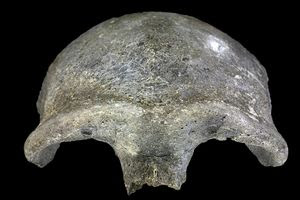Монгол орон дэлхийн түүхийн хүний үүслийн өлгий нутгуудын нэг гэдэг нь батлагдаж байна. Энэ зулайн яс нь Хэнтий аймгийн Салхитаас 2006 онд олдсон Хомо Гейдельберг болон Хомо Еректусын сүүлийн үед хамаарах олдвор болно. Ойролцоогоор 20.000 жилийн эрин үед хамаарна. Ямарч байсан манай орны түүхийн нэгэн баримт олдвор мөн учир орууллаа шүү. Нөхдөө (:
Зүйлийн жагсаалт
Үүнд анхнаас нь хойш хүртлэх дэс дарааллаар
• Sahelanthropus
o Sahelanthropus tchadensis
• Orrorin
o Orrorin tugenensis
• Ardipithecus
o Ardipithecus kadabba
o Ardipithecus ramidus
• Australopithecus
o Australopithecus anamensis
o Australopithecus afarensis
o Australopithecus bahrelghazali
o Australopithecus africanus
o Australopithecus garhi
• Paranthropus
o Paranthropus aethiopicus
o Paranthropus boisei
o Paranthropus robustus
• Kenyanthropus
o Kenyanthropus platyops
• Homo
o Homo habilis
o Homo rudolfensis
o Homo ergaster
o Homo georgicus
o Homo erectus
o Homo cepranensis
o Homo antecessor
o Homo heidelbergensis
o Homo rhodesiensis
o Homo neanderthalensis
o Homo sapiens idaltu
o Homo sapiens (Cro-magnon)
o Homo sapiens sapiens
o Homo floresiensis
Үүнд анхнаас нь хойш хүртлэх дэс дарааллаар
• Sahelanthropus
o Sahelanthropus tchadensis
• Orrorin
o Orrorin tugenensis
• Ardipithecus
o Ardipithecus kadabba
o Ardipithecus ramidus
• Australopithecus
o Australopithecus anamensis
o Australopithecus afarensis
o Australopithecus bahrelghazali
o Australopithecus africanus
o Australopithecus garhi
• Paranthropus
o Paranthropus aethiopicus
o Paranthropus boisei
o Paranthropus robustus
• Kenyanthropus
o Kenyanthropus platyops
• Homo
o Homo habilis
o Homo rudolfensis
o Homo ergaster
o Homo georgicus
o Homo erectus
o Homo cepranensis
o Homo antecessor
o Homo heidelbergensis
o Homo rhodesiensis
o Homo neanderthalensis
o Homo sapiens idaltu
o Homo sapiens (Cro-magnon)
o Homo sapiens sapiens
o Homo floresiensis
Two possible late-surviving Neanderthals from China and Mongolia
Dr Jeffrey Meldrum recently published a paper advancing the idea that some of the presumed fossil types of humans other than modern man could have survived up until more modern times and could be connected to modern reports of Bigfoot and the like. His paper included two examples of what look to be Neanderthal types from Mongolia and China in the vicinity of 10000 to 20000 BC, at the end of the Ice Age and much later than the usually-accepted date for the last surviving Neanderthals (There are at least two such late-Neanderthal sites in Europe to my knowledge but Meldrum did not mention them) His description of the specimen illustrated below is as follows:
A remarkably complete specimen of a pre-modern hominin, displaying archaic features of the skull and skeleton, was recovered from the site of Lishu, just outside Beijing, China, with a preliminary date of 12000 to 20000 years ago.(Lu, Personal communication) It is on display at the Peking University

I do also have a fairly good translation for the publication on the Mongolian example, potentially to be connected to the reports of the Almas in that region
Saturday, March 15, 2008
UNCOVERING REMAINS OF ARCHAIC SAPIENS IN MONGOLIA
The famous paleoanthropologist Yves Coppens and colleagues discovered skeletal remains of Homo sapiensarchaic in northern Mongolia. You appear to have similarities with Neanderthals , Chinese Homo erectus and Archaic Homo sapiens.
 |
| In an office of the Mongolian Academy of Sciences, Professor Yves Coppens and Pierre-Henri Giscard, examining the skull of "Mongolanthropus" (Upper Paleolithic, about 22,000 years BP) |
These remains are unmatched in the region, having never had human fossil discovered in the area.
The remains were discovered in 2006 in northeastern Mongolia where a company was looking for gold in the cave of Salkhit. The workers found them 6 meters underground in a pit. Cranial remains are very fragmentary but well preserved: a full frontal bone and two parietal incomplete.
Could not be dated with certainty yet, but it was estimated at a Late Pleistocene date, that is between 12,6 thousand and 10 thousand years. The dating was based indirectly about rhinos associated with human remains.
Despite having many features Neanderthals , the remains were not associated with that species, but recently discovered Neanderthals in Siberia. But the authors do believe that there might be some relationship.
"The scientific community," say the authors in the study, "considers the Neanderthals as a European group rather than Asia, with relatively recent settlements in Asia. Although based on the dating of fossils, this assumption should be tempered and should take more account of the discoveries in Teshik Tash, Uzbekistan, and Okladnikov and Denisova, southeastern Siberia. "
And is that the show remains a mosaic of features. The features Neanderthals who are at residues "are located at the bottom of the frontal bone, in the nasal region and the orbital".
"Multidimensional Analysis clearly differentiate Salkhit skull fossils of [modern]Homo sapiens from the Far East, "the authors conclude. In contrast, comparisons show similarities with archaic groups composed ofNeanderthals , Chinese Homo erectus and archaic Homo sapiens both the West and the Far East. Unfortunately, the incompleteness of the fossil does not allow a comparison more feaciente. For this reason, we attribute cautiously Salkhit the remains of an archaic Homo sapiens. "
References
http://www.sciencedirect.com/science/article/pii/S1631068307001650
http://frontiersofzoology.blogspot.com/2012/05/two-possible-late-surviving.html
Coppens Y, Tseveendorj D, Demeter F, Turbat T, Giscard P-H. 2008. Discovery of an archaic Homo sapiensskullcap in Northeast Mongolia. Compte Rendus Palévol (in press) doi:10.1016/j.crpv.2007.12.004
Coppens Y, Tseveendorj D, Demeter F, Turbat T, Giscard P-H. 2008. Discovery of an archaic Homo sapiensskullcap in Northeast Mongolia. Compte Rendus Palévol (in press) doi:10.1016/j.crpv.2007.12.004
Another link
http://bodonguudbatchuka.blogspot.com/2011/12/50000-40000.html
http://bodonguudbatchuka.blogspot.com/2012/03/blog-post.html?utm_source=BP_recent&utm-medium=gadget&utm_campaign=bp_recent
http://bodonguudbatchuka.blogspot.com/2012/06/blog-post_12.html
http://bodonguudbatchuka.blogspot.com/2011/12/homo-habilis-homo-habilis-2.html?utm_source=BP_recent&utm-medium=gadget&utm_campaign=bp_recent
http://www.institutdesdeserts.com/page9/page9.html
The term "Archaic Homo sapiens" can be used to include Neanderthals and the broader category of other fossils like them, including the "Rhodesian man" and "Heidelberg man." The authors of this study seem to consider Neanderthals entirely European and because of that they use the broader classification for these remains.

http://bodonguudbatchuka.blogspot.com/2012/03/blog-post.html?utm_source=BP_recent&utm-medium=gadget&utm_campaign=bp_recent
http://bodonguudbatchuka.blogspot.com/2012/06/blog-post_12.html
http://bodonguudbatchuka.blogspot.com/2011/12/homo-habilis-homo-habilis-2.html?utm_source=BP_recent&utm-medium=gadget&utm_campaign=bp_recent
http://www.institutdesdeserts.com/page9/page9.html
The term "Archaic Homo sapiens" can be used to include Neanderthals and the broader category of other fossils like them, including the "Rhodesian man" and "Heidelberg man." The authors of this study seem to consider Neanderthals entirely European and because of that they use the broader classification for these remains.



No comments:
Post a Comment